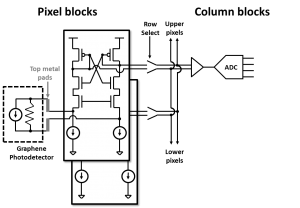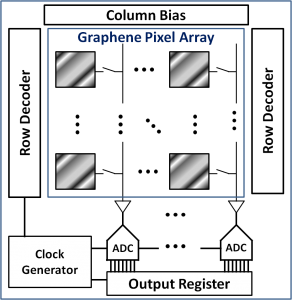Graphene-based Wide-spectrum CMOS Image Sensor
- Category: Circuits & Systems
- Tags: anantha chandrakasan, sungjae ha
CMOS image sensors are widely used in digital multimedia applications, and its performance ramps up every year with denser integration, better noise suppression, adjustable dynamic range, and lower power[1]. However, the band gap of silicon fundamentally limits the absorption spectrum to the visible and near-infrared light (λ < 1100nm)[2]. In our research, we propose an integrated CMOS imager with a graphene photodetector. Thanks to its zero band gap, the graphene photodetector absorbs long wavelengths (λ > 1μm) and enables integrated circuits (ICs) for wide-spectrum imaging applications such as thermal and terahertz imaging.
In the design of the graphene photodetector, graphene’s high conductivity is a key problem because the charge generated by the photovoltaic effect at the graphene-metal junctions easily leaks back. Also, the low output impedance severely limits the output voltage of the graphene photodetector to only a few microvolts, which degrades the signal noise ratio (SNR). To resolve the leakage issue and improve SNR, we propose to use a modulated input source. The mechanical shutter working at around 1 kHz shifts the input signal out from DC region where the leakage component dominates. The modulation also suppresses flicker noise in the photodetector and the readout circuits, by a band pass filter followed by a multi-stage low noise amplifier.
Figure 1 shows the pixel circuit design of a modeled graphene photodetector and a transimpedance amplifier. Unlike p-n junction photodiodes[3], the graphene photodetector is placed on top of the silicon substrate, requiring no extra area, so higher integration can be achieved in each pixel. The amplitude of the photocurrent is converted to voltage and then measured by an 8b-resolution ADC in a column-parallel architecture as shown in Figure 2. The pixel resolution of the prototype chip is expected to be 80 by 60.
- Figure 1: Image sensor pixel design with a graphene photodetector and a differential transimpedance amplifier
- Figure 2: Top view of the floor plan of a wide spectrum image sensor IC.
- A. Fish and O. Yadid-Pecht, “Low Power CMOS Imager Circuits,” in Circuits at the Nanoscale: Communications, Imaging, and Sensing, K. Iniewski, Boca Raton: CRC Press/Taylor & Francis, 2009. [↩]
- R. Kaufmann, “Near infrared image sensor with integrated germanium photodiodes,” Journal of Applied Physics, vol. 110, pp. 023107-6, July 2011. [↩]
- M. Perenzoni, N. Massari, D. Stoppa, L. Pancheri, M. Malfatti, and L. Gonzo, “A 160×120-Pixels Range Camera With In-Pixel Correlated Double Sampling and Fixed-Pattern Noise Correction,” IEEE Journal of Solid-State Circuits, vol. 46, pp. 1672-1681, 2011. [↩]

